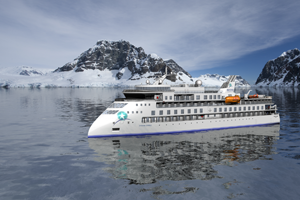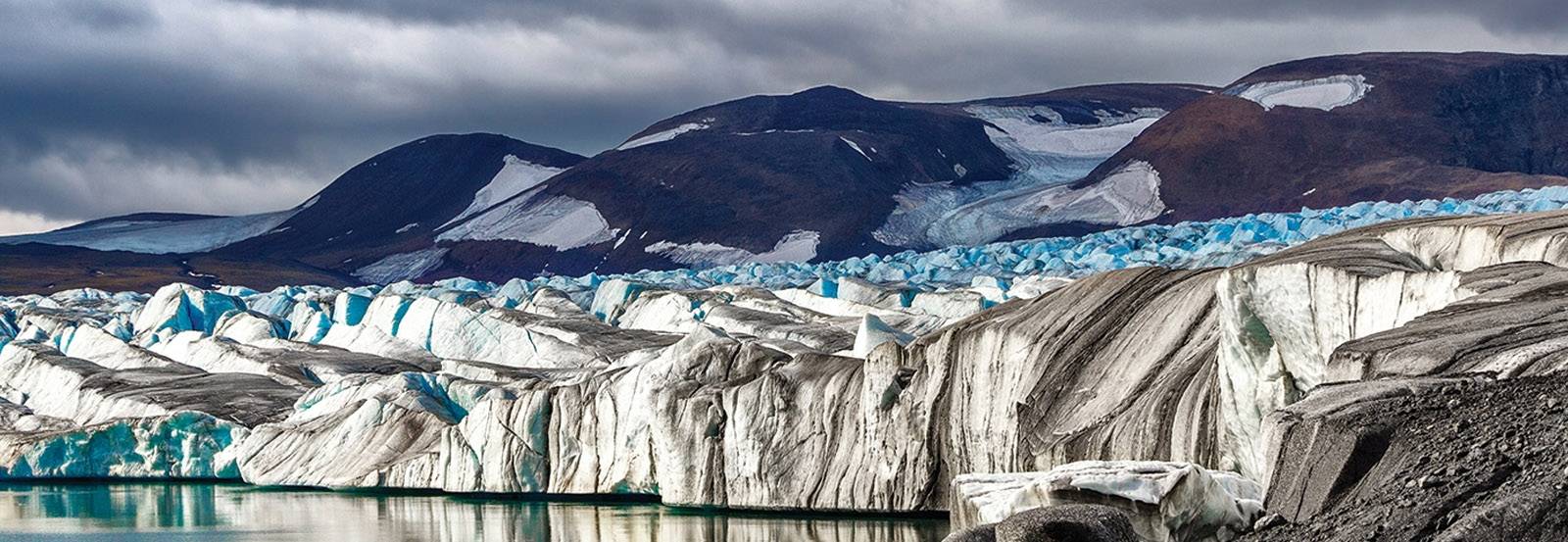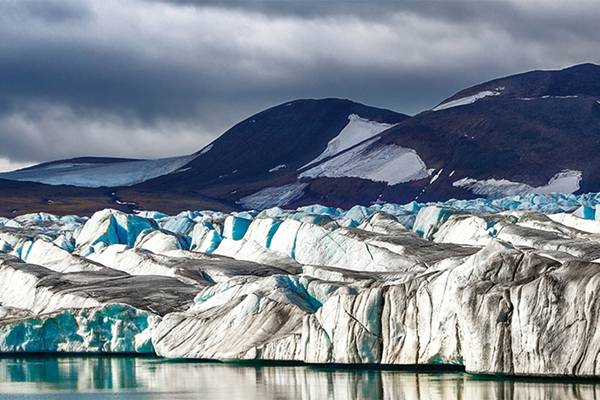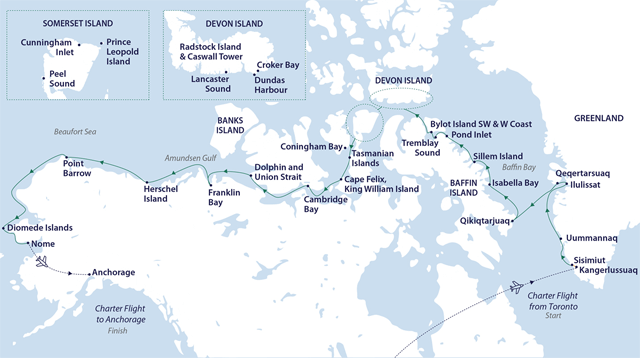HIGHLIGHTS
- Stand
in awe of Ilulissat Icefjord, a UNESCO World Heritage Site
- Hike
on Devon Island, the world’s largest uninhabited island,
which features stunning geology, fjords and glacial valleys to explore
- On
Beechey Island, visit memorials and graves of explorers from John
Franklin’s expedition
- Keep
watch with the hope of spotting iconic Arctic wildlife including musk
ox, polar bears, beluga whales, walrus and perhaps narwhal
DATES / RATES
Rates are listed per person
|
| Start Date | End Date | From EUR | From USD |
|---|
| Aug 27, 2025 | Sep 24, 2025 | 39,204 |
44,395 |
Rates are listed per person
|
| Start Date | End Date | From EUR | From USD |
|---|
| Aug 27, 2025 | Sep 24, 2025 | 39,204 |
44,395 |
ITINERARY
Day
1 Toronto
Having
made your way to Toronto Airport, check-in at Westin Toronto Airport
Hotel for an overnight stay. At our welcome briefing this evening,
enjoy a drink and meet fellow expeditioners. A representative from
Aurora Expeditions will provide you with important information about
biosecurity and also about the charter flight to Kangerlussuaq
tomorrow. You will receive Aurora Expeditions cabin tags for your
luggage. Please clearly label the tags with your name and ship cabin
number.
Accommodation:
Westin Toronto Airport Hotel (or similar)
Day
2 Kangerlussuaq
After
breakfast at the hotel, board our charter flight to Kangerlussuaq,
Greenland, where our vessel Sylvia Earle awaits. After boarding, there
is time to settle into your cabin before our important safety
briefings. The sailling out of Søndre Strømfjord,
with its towering mountains on both sides, is magnificent. This
evening, meet your expedition team and crew at the Captain’s
Welcome Dinner.
Day
3 Sisimiut
Greenland’s
second largest town, Sisimiut is located approximately 54 kilometres
(33.5 miles) north of the Arctic Circle, meaning that during summer,
you can experience the midnight sun here. The town is famous for the
old blue church with the gate made of whale bone. In the cosy museum
next door to the church, you will find an excellent reconstruction of
an Inuit turf house as well as exhibits of local history and early life
in Greenland.
Sisimiut
offers hiking trails with various degrees of difficulty. The easier
trails take you through the town itself, its outskirts and into the
mountains, where you will find spectacular vantage points.
Approximately
4,500 years ago, the Saqqaq culture arrived from Canada and settled in
the area. They lived here for approximately 2,000 years, after which
they mysteriously disappeared from the area. The Dorset
culture arrived around 500 CE and stayed until the 1200s until they
were replaced by the Thule culture, and today, the majority of the
population of Sisimiut are descendants of the Thule culture.
Day
4 Ilulissat
Known
as the ‘birthplace of icebergs’, this region
produces some of the most dazzling icebergs found anywhere in the
Arctic. Hike past the husky sledge dogs to the UNESCO World
Heritage-listed Icefjord and stand in awe of its immensity. Sermeq
Kujalleq, also known as Jakobshavn Glacier, is the most productive
glacier – not only in Greenland but the entire Northern
Hemisphere. It produces 20 million tonnes of ice each day, all floating
into the Ilulissat Icefjord and Disko Bay. Conditions permitting, enjoy
a Zodiac cruise at the mouth of the fjord and kayak through sea ice and
icebergs. An optional 90-minute helicopter flight over the icefjord is
a truly once-in-a-lifetime experience.
Optional
helicopter flight (90 mins): this excursion is the only way you can get
close to the gigantic glacier. The 12-seater helicopter departs from
Ilulissat Airport and sweeps over hills, lakes and ice fjords. Land on
the mountain at Kangia, in the middle of the preserved area, where you
can revel in the incredible surroundings. On the return flight to
Ilulissat, fly above the edge of the glacier with breathtaking views of
the massive icebergs drifting in the fjord. The views of some of the
largest icebergs that become stranded on a moraine underneath the
water, just outside the town, offers a wonderful finale to this
excursion. (Additional charge applies). Please note this
excursion requires a minimum of 8 people to operate.
Day
5 Qeqertarsuaq (Disko Island)
This
compelling island seems to have more in common with Iceland than
Greenland. While most of the interior is mountainous and glaciated, its
beautiful shorelines boast black sandy beaches, unusual basalt columns,
hot springs and dramatic lava formations. On a guided hike, enjoy a
diversity of Arctic flora. Zodiac cruise in Disko Bay, a hotspot for
marine life including humpback, fin, minke and bowhead whales. The
small friendly village has a fascinating historical museum.
Day
6 At sea, Qikiqtarjuaq (Baffin Island)
Our
team of experts entertain us with informative talks about wildlife,
geology and epic tales of early explorers such as Franklin and
Amundsen. Reaching the coast of Baffin Island, we may encounter
Greenland’s famous icebergs. Keep watch for humpback, sei,
sperm and fin whales, as well as various species of seals such as ring
and harp seal.
Day
7 Isabella Bay
Farther
north along the east coast of Baffin Island we visit Isabella Bay, an
important summer and autumn feeding ground for a large population of
bowhead whales.
Day
8 Sillem Island
We
sail around Sillem Island, with glacial features on all sides. A slow
cruise offers the chance to see many glaciers, discharging cascades as
well as a variety of seals and other arctic wildlife.
Day
9 Pond Inlet (Mittimatalik), Tremblay Sound
The
picturesque hamlet of Pond Inlet, overlooking Eclipse Sound, is
surrounded by scenic mountain ranges and numerous glaciers and fjords.
Travellers come to marvel at the abundant wildlife hoping to see
narwhals, beluga and orca whales, ringed and harp seals, caribou and
the occasional polar bear. Explore churches and visit the Natinnak
Centre to see exhibits showing the culture and history of the local
Inuit people. Husky dog pens are near the landing beach.
In
the afternoon, we visit Tremblay Sound and enjoy a ship cruise. The
area is well-known to attract narwhals that spend summer here. If we
are extremely lucky, we may catch a glimpse of these notoriously shy
creatures that are related to whales and dolphins.
Day
10 Bylot Island, Navy Board Inlet
This
morning, we sail along coastline of Bylot Island. Covered with
mountains, icefields, steep cliffs, snowfields and glaciers, Bylot
provides nesting habitat for large numbers of thick-billed murres and
black-legged kittiwakes. A total of 74 unique species of arctic bird
thrive on this island. Due to the richness of the wildlife and the
beauty and diversity of the landscapes in the area, a large portion of
the island was also included in the Sirmilik National Park, established
in 2001.
We
also plan to visit nearby Navy Board Inlet, an arm of Lancaster Sound
that is uninhabited. The inlet is part of Sirmilik National Park and
provides stunning views of Bylot and Devon islands, with awe-inspiring
scenery including mountains, picturesque fjords, inlets, glaciers, and
icebergs. Marine animals including polar bears, narwhal and whales,
seals and seabirds frequent the area so keep your cameras and
binoculars ready to hopefully spot some wildlife.
Day
11 Dundas Harbour, Croker Bay
Croker
Bay features a number of active glaciers, and a Zodiac cruise, at a
safe distance, is a thrilling adventure. In Dundas Harbour, we plan to
anchor and Zodiac ashore, keeping watch for walrus that are often seen
in the bay, for a walk across tundra where it is possible to encounter
musk ox, enjoy birdwatching, and visit ancient semi-subterranean Thule
huts and a former Royal Canadian Mounted Police outpost.
Day
12 Beechey Island, Lancaster Sound
At
the western end of Devon Island lies Beechey Island. Named after
Frederick William Beechey, the island has many of Canada’s
most important Arctic relics and is a designated Canadian National
Historic Site. Sir John Franklin’ first winter, 1845-46, was
spent here during his attempted to sail through the Northwest Passage
aboard HMS Erebus and HMS Terror, with perilous results – the
first three of his men died here. Roald Amundsen landed at Beechey
Island in 1903, during the first successful voyage to fully transit the
Northwest Passage from the Atlantic Ocean to the Pacific Ocean.
Days
13–17 Expedition cruising
In
true expeditionary style, our itinerary for the following days is
entirely dependent on unpredictable sea ice. The following are places
we hope to visit.
Prince
Leopold Island, Port Leopold
On
the southern side of Lancaster Sound opposite Beechey Island lie the
towering bird cliffs of Prince Leopold Island— the most
important bird sanctuary in the Canadian Arctic, with approximately
500,000 birds nesting pairs here in summer. Ringed seals are often
spotted on the sea ice. Nearby Port Leopold is a historic site
where British explorer James Clark Ross wintered in 1848 while
searching for the missing Franklin expedition. The ruin of a century
old Hudson’s Bay trading post can be found there, and polar
bear often lurk nearby. The shallow gravel beds attract beluga whales,
which come to moult in this part of the Arctic each summer.
Cunningham
Inlet
On
the north coast of Somerset Island, when factors such as weather and
whale behaviour align, you might see the amazing spectacle of hundreds
of beluga whales shedding their skin on shallow sandy banks. The local
scenery makes for excellent guided walks, where waterway trails lead to
waterfalls and higher ground.
Coningham
Bay
Across
from Victoria Strait, Coningham Bay lies on the shores of Prince of
Wales Island. This is a polar bear hotspot where the majestic creatures
come to feast on beluga whales that are often trapped in the rocky
shallows at the entrance to the bay. It is not unusual to find the
shoreline littered with whale skeletons – and very
healthy-looking polar bears!
King
William Island
In
1859, a Franklin expedition tent camp was discovered at Cape Felix.
Remains attributed to the Franklin expedition have been found at 35
different locations on King William Island and on nearby Adelaide
Peninsula. South of Cape Felix, in Victoria Strait, we hope to visit
Victory Point and get close to where the HMS Erebus and HMS Terror were
abandoned in 1848.
Day
18 Cambridge Bay
A
large town by local standards, Cambridge Bay is the administrative and
transportation hub of the region. It is the largest stop for passenger
and research vessels traversing the Northwest Passage and unofficially
marks the midpoint for voyages of the Northwest Passage. Zodiac ashore
for an exploration of this Inuit settlement located in the high arctic.
Enjoy a walk through the village, where you can visit the local church,
visitor centre and support the local community by purchasing some
locally made handicrafts.
In
the old town, we plan to visit the ancient archaeological sites of the
Pre-Dorset, Dorset and Thule people.
Wildlife
abounds in this area, and you might see caribou, musk ox and seals. The
tundra is ablaze with wildflowers and birds including jaegers, ducks,
geese and swans visit the area in large numbers.
Day
19 Johansen Bay, Edinburgh Island
Edinburgh
Island is a small and uninhabited island in Canada’s Nunavut
region. The scenery consists of colourful flowering shrubs, beaches
tinged in stunning ochres, while the surrounding cliffs shaded in rich,
deep tones. We hope to enjoy a Zodiac excursion within an estuary of at
the northeast end of Johansen Bay and up the river towards the lake. A
possible walk to a lookout overlooking the lake offers spectacular
views over lakes, sea and mountains. Wildlife including caribous,
reindeer, arctic foxes, hares and peregrine falcons frequent the area.
Day
20 At sea
Enjoy
the many facilities aboard the Sylvia Earle as we continue along the
shores of the Canadian High Arctic. Enjoy panoramic views from one of
the observation lounges, attend informative talks from our onboard
experts or sweat it out in the gym or the sauna.
Day
21 Jesse Harbour, Banks Island
Located
in the north of Canada’s Northwest Territories, Banks Island,
the fifth largest island in Canada, is home to approximately 60 per
cent of the world's population of Lesser Snow Geese. Arctic foxes,
wolves, polar bears, caribous, musk ox and many birds are also found
here. Grizzly bears are occasionally spotted and bowhead whales are
often seen offshore. The dramatic cliffs on the southeast coast feature
colourful yellow, white and red quartzites, while, on the west coast is
characterized by long, sandy offshore bars. Nelson Head cliffs features
ancient Precambrian rock that is almost 2 billion years old.
Day
22 Smoking Hills, Franklin Bay
The
smoking Hills in Canada’s Northwest Territories have been
smouldering, sending plumes of gas across the landscape, for centuries.
Technically sea cliffs, you would be forgiven for thinking that the
multicoloured fiery natural phenomenon is the set to an apocalyptic
movie depicting the end of the world. The smoke is caused by layers of
combustible, sulphur-rich lignite (brown coal) that ignites and emit
sulphurous gas into the air, when exposed to erosion and landslides,
which also creates a dazzling colouration of the rocks.
Day
23 At Sea
As
we continue our journey west, sailing through waters named after famous
explorers such as Amundsen Beaufort, keep a close watch for marine
wildlife including Beluga whales that are often seen here.
Day
24 Herschel Island
Lying
5 km (3.1 mi) off the north coast of the Yukon in the Beaufort Sea,
Herschel Island has a heritage of natural and natural importance. Its
dry polar climate is home to a unique number of arctic plants, animals
and sea life. More than 100 other species of birds live or migrate
here, and the western arctic’s largest colony of black
guillemots nest in Pauline Cove. The island is also a habitat for musk
oxen, caribou, arctic and red foxes. Seals are often spotted on the sea
ice, while bowhead and beluga whales frequent the waters. Apart from
the dazzling wildlife and historic buildings found on the island, it is
the stunning wildflowers, flourishing in the 24 hours of midnight sun
daylight, that most visitors remember.
Day
25 Point Barrow
Point
Barrow, or ‘Nuvuk’ in the local Inuit language, is
a headland on the Arctic coast in the U.S. state of Alaska. It is the
northernmost in the United States, and where we enter the country. The
North Pole is only 1,122 nautical miles (2,078 km /1,291 mi) away. The
area is home to the Inupiat, an Inuit tribe that have lived in the area
for more than 1500 years. Bowhead whales migrate through the region, so
keep a close watch for a glimpse of them. A bowhead whale’s
jawbone sits on the shore on the outskirts of Utqiagvik town, formerly
known as Barrow. The of the whale is in the form of an archway that
faces the Chukchi Sea, symbolising the important relationship between
the Inupiat and the sea.
Days
26-28 At sea
Continuing
west along the northern coast of Alaska to where the U.S and Russia are
only 100 km (60 miles) apart, separated by the Bering Sea, there is
ample time to reflect on our adventures while scanning the water for
marine life. Enjoy a massage in the wellness centre, share, edit and
submit pictures in our photo competition and attend final lectures from
our team of onboard experts. Celebrate an unforgettable voyage at the
Captain’s Farewell Dinner on board.
Day
29 Disembark in Nome, fly to Anchorage
In
Nome, farewell your expedition team and crew after sharing a
once-in-a-lifetime voyage together. After disembarking, we transfer to
the airport for flight to Anchorage for an overnight stay.
Accommodation:
Hilton Hotel Anchorage (or similar)
Day
30 Depart Anchorage
Transfer
to the airport for your onward journey.
Please
note that this is an indicative itinerary only and is subject to
change. Sea ice and weather conditions determine our route, and Aurora
Expeditions cannot guarantee the complete crossing of the Northwest
Passage to the Beaufort Sea.
However,
we will certainly have an incredible adventure trying!
Sylvia Earle (Luxury Expedition, 126-guests)
Due to sail in October 2021 our new ship honours the highly accomplished marine biologist, oceanographer and explorer, Sylvia Earle. As the first female chief scientist of the U.S. National Oceanic and Atmospheric Administration, and named by Time Magazine as its first Hero for the Planet in 1998 - this vessel pays tribute to Sylvia's long standing conservation efforts for marine protected areas and ocean wildlife. Sylvia Earle will be actively involved in the development of her namesake.
 (Click image to view Ship details)
(Click image to view Ship details)
WHAT'S INCLUDED
- All
airport transfers mentioned in the itinerary.
- One
night’s hotel accommodation including breakfast, in Toronto
on Day 1.
- Charter
flight from Toronto to Kangerlussuaq on Day 2.
- Flight
(group allocation) from Nome to Anchorage on Day 29.
- One
night's hotel accommodation including breakfast, in Anchorage on Day 29.
- Onboard
accommodation during voyage, including daily cabin service.
- All
meals, snacks, tea and coffee during voyage.
- Beer,
house wine and soft drinks with dinner.
- Captain’s
Welcome and Farewell receptions including four-course dinner, house
cocktails, house beer and wine, non-alcoholic beverages.
- All
shore excursions and Zodiac cruises.
- Educational
lectures and guiding services provided by our expedition team.
- Complimentary
access to onboard expedition doctor and medical clinic (initial
consultation).
- One
3-in-1 waterproof, polar expedition jacket.
- Complimentary
use of Muck Boots during the voyage.
- Comprehensive
pre-departure information.
- Port
surcharges, permits and landing fees.
- Gratuities
for ship’s crew and local guides.
Exclusions
- International
or domestic flights – unless specified in the itinerary.
- Transfers
– unless specified in the itinerary.
- Airport
arrival or departure taxes.
- Passport,
visa, reciprocity and vaccination fees and charges.
- Travel
insurance or emergency evacuation charges.
- Hotel
accommodation and meals – unless specified in the itinerary.
- Optional
excursions and optional activity surcharges.
- All
items of a personal nature, including but not limited to alcoholic
beverages and soft drinks (outside of dinner service), laundry
services, personal clothing, medical expenses, wi-fi, email or phone
charges.
ADVENTURE
OPTIONS
- Sea
Kayaking:
USD 1,660 per person
- Photography:
FREE
- Bird
watching
- Lectures
on wildlife, our environment, history and destinations
- Polar
plunge
- Trips
ashore
- Walking
- Whale
and mammal spotting
- Zodiac
cruises







